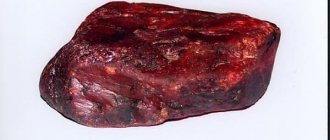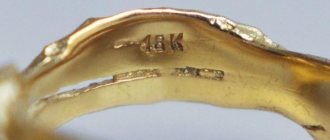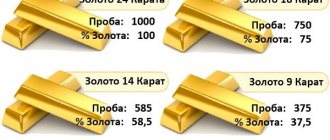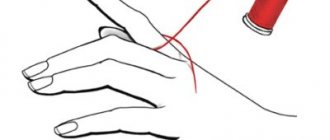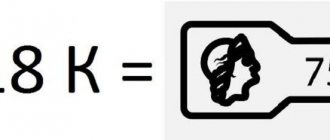Precious minerals, due to their splendor and radiant shine, have always attracted the eyes of people and become objects of admiration. However, what makes stones so expensive is not only their external beauty, but also their rarity. The cost of unique specimens reaches sky-high levels.
An equally important parameter for setting the price is the weight of the mineral. To measure the mass of precious stones, a non-standard unit is used - the carat, which is well known to jewelers. However, for an uninformed person, the weight of a carat in grams remains a mystery, so before buying expensive jewelry inlaid with diamonds or sapphires, you should know how much one carat weighs and how to determine the number of grams in a gem.
What is carat
To measure the mass of precious stones, the carat is used - a unit that has the designation ct and is equal to 0.2 grams. In England, the same value is used to determine the percentage of gold in the setting, but in this case the unit is abbreviated “K”.
It is important to note that the size of a gem is not measured in ct, since this is a unit of mass, not dimensions. In addition, the parameters of the jewelry insert largely depend on the cutting method by which the crystals take shape.
To determine the cost and value of a mineral, one must know how many cts are contained in a particular sample. When purchasing, do not forget that purity also affects the price, so more does not always mean better.
Round Diamonds – How to Divide them
Round diamonds are grouped according to the quality of their finish. These can be group stones:
- A – flawless specimens;
- B – high rating;
- B – rating “good”;
- G – means “satisfactory”.
The large solitaire with a high level of finishing shines especially brightly. In turn, small diamonds play with light almost imperceptibly. Round solitaires, unlike square and fancy-shaped stones, in addition to powerful brilliants, have sparkle, for which they are valued higher. Such solitaires attract attention, shimmering with all the colors of the rainbow and emitting an inner glow.
History of the unit
The history of the origin of the carat as a unit of measurement goes back to earlier times. In the old days there were no scales, so merchants and jewelry dealers had difficulty selling jewelry by original weight. A unified measurement system was invented that compares the size and mass of minerals.
To determine the weight of gems, grains of carato, a ceratonia plant that grew in the area where mineral mining took place, began to be used. In other countries, acacia grains were used as weights. However, the name “carat” owes its appearance to ceratonia. The fact is that the fruits of this tree had the same mass - 0.19 grams - regardless of the place of growth and time.
The measurement was officially agreed upon in 1907 during the Fourth General Conference.
In the USSR, official approval was received in 1922. From that moment on, the mass of jewelry began to be determined in ct.
Carat hallmark
The carat is not only a unit of mass , but also a way of expressing the purity of gold (this system is not usually applied to other precious metals, for example, silver, platinum, palladium). In Canada, to avoid confusion, there are even different ways of writing the word: carat means unit of mass, and karat means sample.
The carat standard is used in America, Canada, Western Europe, Ireland, and Great Britain along with the metric standard. These two systems are easily converted into each other: dividing the carat by 24 and then multiplying by 1 thousand gives the metric value.
This recalculation is due to the fact that the system is based on the number of carats of gold in 24 carats of the entire alloy. Jewelry typically ranges from 9 to 24 ct.
Kinds
In the modern world, there are two types of units for measuring the mass of jewelry - metric and assay carat. The first is a measure of the weight of precious stones, the second determines the purity of the gold alloy.
Metric
The metric carat is a unit of measure adopted in all developed countries. Metric cts are used to measure the mass of unique and dazzling diamonds. The history of the origin of the unit of measurement goes back to antiquity, where the mass of minerals was determined using ceratonia fruits, which have an identical weight - 189 mg.
Difficulties began when traders discovered that the fruits differed in different countries. This created inconvenience and caused conflicts between merchants. As a result, the idea of adopting a single unit of mass arose, but this was opposed by Great Britain, which adhered to its metric system. Despite the difficulties, the jewelers soon agreed on a single ct - 0.2 grams.
Assay
This type is different from the metric carat and denotes a measure not of weight, but of the purity of the gold alloy. The hallmark carat was invented in Ancient Rome, when the emperor introduced a gold coin that weighed 24 K. A similar coin is still in active circulation in Great Britain. Other countries prefer to use percentages, for example, the 585-carat designation indicates that the jewelry contains 58.5% pure gold.
When using an assay unit to determine the purity of gold, the following ratio is taken: 24K is the pure metal content. Therefore, a piece containing half gold would be 12K. In Russia, the jewelry industry produces jewelry with hallmarks of 750, 585, and 375—18, 14, and 9 K, respectively.
Carat hallmark
The carat is not only a unit of mass , but also a way of expressing the purity of gold (this system is not usually applied to other precious metals, for example, silver, platinum, palladium). In Canada, to avoid confusion, there are even different ways of writing the word: carat means unit of mass, and karat means sample.
The carat standard is used in America, Canada, Western Europe, Ireland, and Great Britain along with the metric standard. These two systems are easily converted into each other: dividing the carat by 24 and then multiplying by 1 thousand gives the metric value.
This recalculation is due to the fact that the system is based on the number of carats of gold in 24 carats of the entire alloy. Jewelry typically ranges from 9 to 24 ct.
Difference between gold and diamond carats
To answer the question of how diamond carats differ from gold carats, it should be understood that these two definitions are used for different purposes:
- Diamond (metric) carats are used to indicate the weight of minerals, which include famous diamonds. The weight of one carat is 0.2 grams, the designation is ct.
- Gold (assay) standards determine the amount of pure gold and have the abbreviation K. In some countries, for example, in Russia, jewelry is made with hallmarks that can easily be converted to K.
The system for measuring the weight of gems and the gold content goes back to ancient times and is still used today. In the jewelry industry, carat scales with minimal error are used to determine weight in grams. To calculate carat content, there are many tables with the help of which even a person ignorant in this area can calculate the number of grams.
Ounce
For trading on the stock exchange, the troy ounce is used, which is a fairly accurate measurement. It should not be confused with those previously described. A troy ounce corresponds only to pure gold, with a purity level of 999 or higher. It indicates the weight of the metal, and in accordance with this helps to find out its price on the world market. By weight it is approximately 31.103 grams. If you purchase investment coins, bars, or a virtual amount of gold through a bank or exchange, you will encounter exactly this value, which is designated as ozt.
How many grams in one carat
At the beginning of the 20th century, jewelers agreed on the exact number of grams in a carat. In 1907, they decided to equate the weight of one carat to 0.2 grams. However, not all countries agreed to convert the mass into carats, continuing to use their own values. The countries adopted a unified standard in the following sequence:
- France - 1907
- Holland - 1911
- USA - 1913
- USSR - 1923
Following these states, other countries also decided to convert grams to carats. However, a 1 ct gem is a rare and expensive stone. Much more often you come across crystals with a smaller mass, not reaching 0.2 grams. But here, too, jewelers did not use standard measures and created their own unit - the point. It has been established that one ct (0.2 grams) is equal to 100 points.
Top 5 large diamonds
The number of crystals weighing 20 carats or more is so small that they are sold only through auction and often even have their own names. One of these stones is the Cullinan crystal. Its solid weight was more than 3,000 carats. It was subsequently broken into 105 pieces of varying sizes.
The pear-shaped diamond, weighing just over 110 carats, was mined in 2010 and was named “Drop of the Sun.” Its cost reaches 15 million dollars.
The Charles Noir diamond originally weighed 421 carats. After processing, it was reduced to 88. The characteristic features of this stone are its black color and the maximum insurance amount (about 37 million dollars).
The most expensive diamond is the 59.6-carat Pink Star stone. It was sold at auction for a record price of $71.2 million. The pink crystal “The Little Prince” closes the top five world leaders. It weighs 34.65 carats and has an original price of $46 million.
In an effort to preserve your own savings, you can pay attention to investing in jewelry, because over time their value does not decrease.
How do the mass and diameter of precious gems relate?
Before visiting a jewelry store, a table of the ratio of the diameter, which is measured in millimeters or centimeters, and the weight of the mineral will help you find out approximately the cost of the stone. It is difficult to know the exact weight of a particular specimen, since the gems that go on sale have different cuts. At the same time, the primary goal of every jeweler is to maintain the weight of the original crystal, so gems of the same diameter can weigh differently.
The table will help you understand the intricacies of the relationship between carat and diameter (mm):
| Diameter in mm | Carat weight |
| 4,1 | 0,25 |
| 5,1 | 0,5 |
| 6,4 | 1 |
| 8,2 | 2 |
| 9,4 | 3 |
| 10,4 | 4 |
| 11 | 5 |
| 14 | 10 |
| 16 | 15 |
Similar tables that exist for each jewelry variety of stones allow you to find out the number of grams without removing the precious insert from the ring or earrings.
Diamond quality rating
The value of a diamond is determined not only by its linear dimensions. The denomination of a gemstone is determined using the “four C” rule, where the decisive characteristics are:
- degree of cut (cut);
- color (color);
- weight (carat);
- purity (clarity).
When determining the degree of cleanliness, all internal and external defects are taken into account: chips, cracks, inclusions. Calculation of product quality is carried out with the naked eye or under a magnifying glass with tenfold magnification. Smaller flaws are not taken into account. The division into groups according to purity in Russia is carried out either according to TU 25−07.1319−77, or according to the GIA system. There are eight of them, with 1 being the highest, without defects, 7a having minor defects in the form of dark inclusions, clouds, and cracks.
To determine the color of a diamond you need to:
- set of samples;
- presence of white illumination;
- additional material providing a white background.
The expert must have at least some experience. The study is carried out according to the GIA system or according to TU 117−4.2099−2002. Transparent diamonds are the most valuable. According to the classification of jewelry stones according to GOST R 52913−2008, the color of diamonds is divided into seven types, with 1 - the most valuable, colorless stones, 7 - black, brown, yellow-brown diamonds.
The cost of crystals increases quadratically to their weight. That is, a 10-carat stone will be not ten, but a hundred times more expensive than a one-carat stone, since 102 = 100. The cut grade is divided into four types:
- A - excellent;
- B - very good;
- B - good;
- G - satisfactory.
In nature, gemstones measuring 1 carat or larger are quite rare.
More often than not, their weight does not reach this value. The measurement uses a unit called “point”, which is one hundredth of a carat.
Diamonds, depending on size and weight, are divided into three main types , shown in the table (for round diamonds).
| Type | Size, mm | Weight, car |
| Small | 1−2 | 0,004−0,029 |
| Average | 2,1−6,4 | 0,034−0,96 |
| Large | 6,5−10 | 1,01−3,55 |
Stones measuring less than 1 mm and weighing up to 0.004 carats are considered diamond chips.


